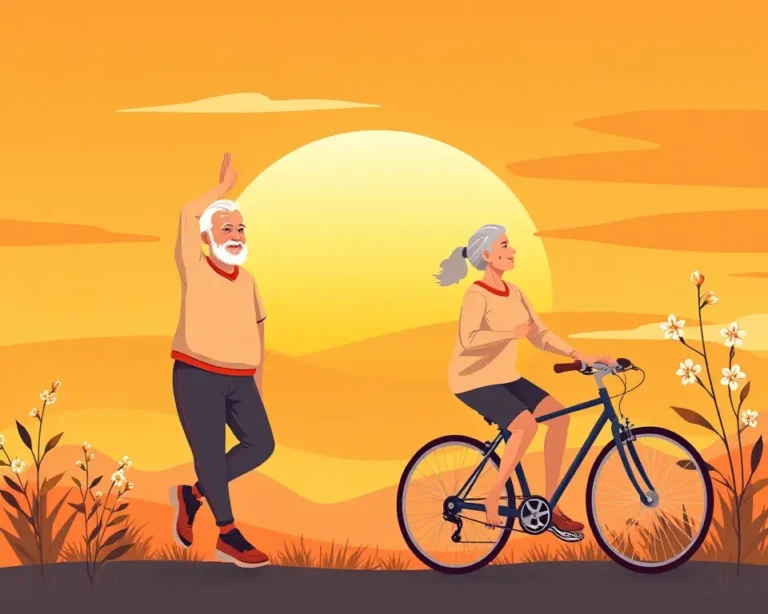Retirement offers a world of possibilities, and among the most rewarding is the chance to prioritize your health. Staying active after retirement isn’t just about maintaining fitness; it’s about enhancing your independence, quality of life, and overall well-being. As our bodies change with age, regular exercise becomes even more vital in combating age-related decline.
The Golden Years, The Golden Rules of Fitness
As we age, our bodies undergo natural changes that can impact our mobility and overall health. However, adopting a consistent exercise regimen can significantly mitigate these effects.
When embarking on a fitness journey after retirement, it’s essential to keep a few golden rules in mind:
- Start Slow and Listen to Your Body: It’s crucial to begin gradually and pay attention to your body’s signals, increasing intensity and duration as you become more comfortable.
- Focus on Low-Impact Activities: Opting for activities that are gentle on the joints can minimize the risk of injury while still providing effective workouts.
- Incorporate Strength Training: Maintaining muscle mass is vital for seniors, and incorporating strength training exercises can help combat muscle loss associated with aging.
- Prioritize Balance Exercises: Improving balance is essential for preventing falls, a common concern among older adults.
Why Staying Active Matters More Than Ever
Regular physical activity offers a multitude of benefits for seniors:
- Reduced Risk of Chronic Diseases: Exercise helps manage or prevent conditions like heart disease, stroke, diabetes, and some cancers. Studies show that exercise training in older people has been associated with health benefits such as decreased cardiovascular mortality.
- Improved Cardiovascular Health: Activities like walking, cycling, and swimming strengthen the heart and improve circulation.
- Enhanced Mobility and Balance: Regular exercise can improve your ability to move freely and maintain your balance, reducing the risk of falls.
- Increased Muscle Strength and Endurance: Strength training helps maintain muscle mass and strength, making everyday tasks easier.
- Better Bone Health: Weight-bearing exercises, like walking and dancing, can improve bone density and reduce the risk of osteoporosis.
- Weight Management: Staying active helps burn calories and maintain a healthy weight, reducing the risk of obesity-related health problems.
- Improved Mental Health: Exercise can boost your mood, reduce stress and anxiety, and improve cognitive function. Regular physical activity can have an immediate impact on morale issues and can also reduce depression and anxiety.
- Increased Social Interaction: Joining exercise classes or groups provides opportunities to socialize and connect with others, combating loneliness and isolation. Half of adults over 60 forge new friendships through exercise, highlighting the social benefits of fitness.
- Increased Energy Levels: Regular physical activity helps increase energy levels, enhance mobility, and maintain independence for longer periods.
Discovering Your Perfect Fitness Routine
Finding activities you enjoy is key to maintaining a consistent exercise regimen. Here’s a look at some popular and effective options for senior fitness:
Low-Impact Cardio
- Walking: A simple yet effective way to stay active. Walking can be done anywhere and is easy to incorporate into daily routines.
- Swimming and Water Aerobics: Workouts in the water are beneficial to seniors in a few ways. Swimming provides a full-body workout, improves cardiovascular health, and is easy on the joints. The warm water of a pool can soothe muscles and joints. Water aerobics is also an extremely popular exercise for seniors. Additionally, water brings natural resistance, which eliminates the need for weights in strength training.
- Cycling: Cycling is an excellent form of exercise for seniors, offering a wide range of health benefits. It provides a low-impact cardiovascular workout that is easy on the joints, making it an ideal activity for older adults who may have arthritis or other joint issues. Regular cycling helps to improve cardiovascular health, increase muscle strength, and enhance flexibility and balance, which can reduce the risk of falls. Cycling also can be adapted to suit individual fitness levels and health conditions.
- Dancing: Dance-inspired exercises, like Zumba Gold or ballroom dancing classes, combine rhythm and fitness, making workouts a pleasure.
Strength Training
- Chair Exercises: Many strength training exercises can be modified to be done while seated, making them accessible for those with limited mobility.
- Resistance Bands: These versatile tools provide resistance for various exercises, helping to build strength without the need for heavy weights.
- Bodyweight Exercises: Exercises like push-ups (against a wall) and squats (using a chair for support) use your own body weight for resistance.
Balance and Flexibility
- Yoga: This ancient practice improves flexibility, balance, and strength, while also promoting relaxation and mindfulness. Chair yoga is a low-impact form of exercise that improves muscle strength, mobility, balance, and flexibility, all of which are crucial health aspects for seniors.
- Tai Chi: This gentle Chinese martial art improves balance, coordination, and flexibility.
- Stretching: Regular stretching can improve flexibility and range of motion, reducing the risk of injury.
Fun and Engaging Activities
- Pickleball: This social and low-impact sport is a great way to get exercise and have fun.
- Gardening: Digging, planting, and weeding are all great forms of exercise that can be enjoyed outdoors.
- Walking or Nature Walk Scavenger Hunts: Turning a simple walk into a scavenger hunt adds excitement and purpose. Individuals can explore parks or neighborhoods while looking for items like flowers, unique rocks or specific bird species. This not only encourages physical activity but also fosters a connection to nature.
Nutrition: Fueling Your Active Lifestyle
Proper nutrition plays a vital role in supporting an active retirement. A healthy diet will keep your muscles and bones strong. This will help to prevent falls and ensure you live an independent life for as long as possible.
Here are some key nutritional considerations for active seniors:
- Protein: Essential for maintaining muscle mass and strength. Include lean proteins like chicken, turkey, fish, beans, lentils, and tofu in your meals.
- Calcium and Vitamin D: Important for bone health. Incorporate dairy products like yogurt, cheese, and milk, which provide protein as well as calcium and vitamin D.
- Fiber: Helps with digestion and can lower the risk of chronic diseases. Eat wholemeal breads and cereals, plenty of vegetables, fruit and salad every day to ensure you are getting enough fibre to help prevent constipation.
- Fruits and Vegetables: Packed with vitamins, minerals, and antioxidants.
- Hydration: Drink plenty of water throughout the day to stay hydrated. Low- or fat-free milk, including lactose-free options or fortified soy beverage and 100% juice can also help you stay hydrated.
Safety First: Exercising Smart
Before starting any new exercise program, it’s important to consult with your doctor, especially if you have any underlying health conditions. They can help you determine what types of exercise are safe and appropriate for you.
Here are some additional safety tips:
- Warm-up before each workout: Prepares your muscles for activity and reduces the risk of injury.
- Cool down after each workout: Helps your body gradually return to its resting state.
- Wear comfortable clothing and supportive shoes: Prevents injuries and allows for freedom of movement.
- Stay hydrated: Drink water before, during, and after exercise.
- Listen to your body: Stop if you feel any pain or discomfort.
- Exercise in a safe environment: Choose well-lit and even surfaces to avoid falls.
- Consider exercising with a friend or in a group: Provides support and motivation.
- Stay hydrated: Drinking enough water is important for everyone, but especially for older adults.
- Exercise in a climate-controlled facility whenever possible: Schedule exercise sessions earlier in the day when temperatures are lower.
Senior-Friendly Fitness Challenges
Consider incorporating enjoyable activities into your routines, turning exercise into a delightful experience rather than a chore.
Here are a few ideas for senior-friendly fitness challenges:
- 30-Day Walking Challenge: Walking is one of the best low-impact exercises for seniors, making it a fantastic starting point. A 30-day walking challenge can gradually increase the time or distance you walk each day. Whether you’re taking a brisk stroll around your neighborhood or exploring nature trails, this challenge is accessible to everyone.
- Flexibility and Balance Challenge: Flexibility and balance tend to decline as we age, but these aspects of fitness are essential for preventing falls and maintaining good posture. A 30-day flexibility and balance challenge can involve daily stretching exercises combined with yoga or tai chi practices.
The Mind-Body Connection: Exercising Your Brain
Physical activity isn’t just about bodily health—it’s a workout for your mind too. Mental stimulation through learning new skills or solving puzzles can help keep cognitive decline at bay.
Here are some ideas to keep your mind sharp:
- Learn a new language: Engaging in language learning can stimulate cognitive function and improve memory.
- Play brain games: Activities like Sudoku, crossword puzzles, and chess can help keep your mind active and engaged.
- Read books and articles: Reading can expand your knowledge and improve your cognitive skills.
- Take up a new hobby: Learning a new skill, such as painting, knitting, or playing a musical instrument, can challenge your brain and promote cognitive health.
Embrace the Active Retirement
Retirement is a time to embrace new opportunities and prioritize your well-being. By incorporating regular physical activity and healthy eating habits into your lifestyle, you can enjoy a fulfilling, active, and independent retirement. Remember to consult with your doctor before starting any new exercise program and listen to your body along the way. With dedication and consistency, you can achieve your fitness goals and enjoy all the benefits that an active lifestyle has to offer.







